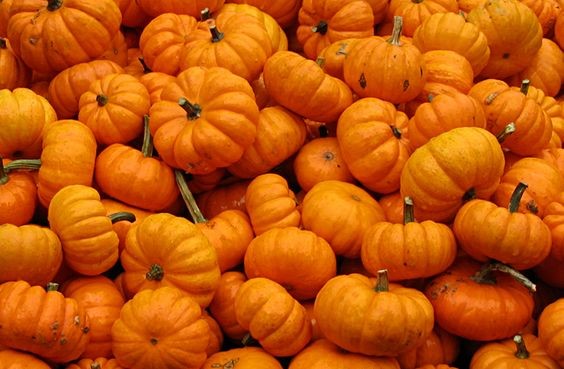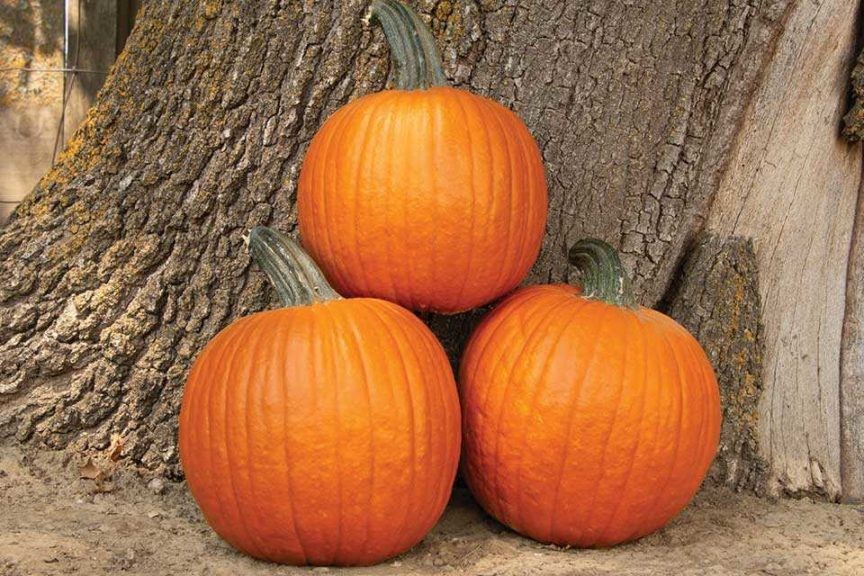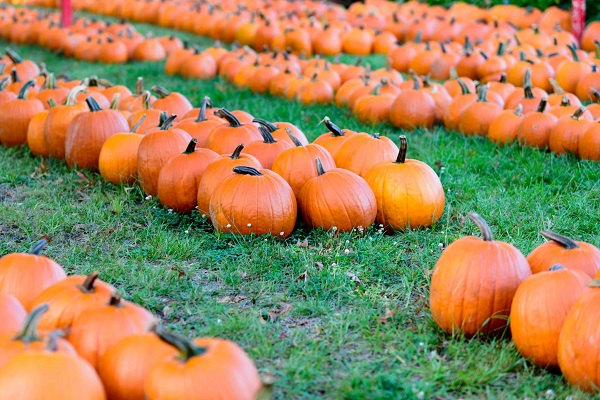The members of the cucurbit family, like squash and pumpkin, take 2 to 4 months before harvesting. With that duration, it is only natural to figure out how many pumpkins per plant you can expect.
Unlike other fruits, pumpkins can only produce a bountiful yield depending on their variety and the quality of their growing conditions.
In this post, we will help you match your yield expectations with the right type of pumpkin and some tips for providing an ideal growing environment.
Knowing what to expect from your pumpkin plants ahead of time will save you from a ‘fall heartbreak’ in case your harvest projections are not met.
Q: How Many Pumpkins Per Plant Can You Harvest?
On average, you can harvest two to five pumpkins per plant. However, these numbers depend on the size of the pumpkin variety that you have.
Here are the respective sizes of pumpkins and their respective average yield:
Small Pumpkin Varieties: 4 to 12 Pumpkins

Small pumpkins are probably the cutest varieties that you can grow in your garden. Contrary to the big pumpkins we often see during fall, they are the ones that can fit the size of your palm. They usually weigh around 1 lb. to 7 lbs. and an average of 2 to 5 inches in diameter.
Due to their size, you can harvest around 4 to 12 pumpkins per plant. They are an ideal variety to grow in small spaces. To maximize the space, some gardeners place them on a vertical trellis. Hanging them up allows the leaves to receive adequate sunlight and allow the fruits to hang like tomatoes.
Here are the small pumpkin varieties that you can choose from:
1. Jack Be Little

As an exact mini version of big pumpkins, growing a Jack Be Little is a spectacular choice. Aside from their adorable appearance, they also have the following features:
- Compact vines that can climb on a vertical trellis.
- Edible fruits and a fun material to paint and decorate during Halloween.
- Grows within 95 (maturity) to 100 days.
- Can produce 8 to 10 fruits on each plant.
- Ideal option for container cultivation.
You can enjoy a bountiful harvest of Jack Be Little during fall. It is frost-sensitive and must start during Spring when the threat of frost has passed.
2. Baby Bear

Baby Bear pumpkin is notable for its shallow ribs and long and thick stems. It has a sweet flavor that’s perfect for pumpkin pies and hull-less seeds that you can roast to turn into a delicious snack.
Here are its other features that might interest you to grow them:
- Takes 105 days to mature
- Tolerant to one to two light frost(Above 28F)
- Can produce 5 to 8 fruits
- Keeping its stem long will help extend its shelf-life
Baby Bear pumpkins are heavy feeders and need a lot of water to grow well. You have to make sure that the soil is fertilized with high doses of nitrogen by adding compost. You can also add some water-retaining soil amendments like mulch to keep the soil moist.
3. Wee B Little Pumpkins

Wee B Little is a baseball-sized pumpkin variety with smooth orange rinds ideal for painting. It’s so small that it only weighs around ½ to 1 pound.
Here are some of the features that might interest you in growing it in your garden:
- Takes 90 to 97 days to mature
- Bush-type vines that make it ideal for container cultivation
- Can produce 3 to 4 fruits per plant
- Has thick dark green stems that serve as an ideal handle
Wee B little is one of the smallest pumpkin varieties that you can grow in the garden. It does not demand too much space. Like Jack B Little, it is also frost-sensitive and loves the heat of the summer.
Medium Pumpkin Varieties: 2 to 3 Pumpkins

Medium-ribbed pumpkin varieties are the stars of the fall season and weigh around 8 to 20 pounds. Due to their size, they can only produce an average of two to three pumpkins per plant.
Unlike the small varieties, the vines of medium-sized pumpkins are more vigorous and require 8 to 10 distance between rows and 4 to 5 feet apart in each row.
Here are the mid-sized pumpkin varieties and their respective yield capacity:
1. Jack-o’lantern

The jack-o’lantern is an heirloom variety popular for being a Halloween staple. It has a round to oblong shape with deep orange color and ribbed skin perfect for painting and carving. Its average weight can range from 7 to 10 pounds and produce one fruit. Check out its other features below:
- Takes 100 to 120 days to mature
- A slow-growing variety
- Vines grow long so it requires a lot of space to grow
- Ideal plant spacing should be 60 to 72 inches apart
2. Connecticut Field

Connecticut Field is a traditional mid-sized pumpkin variety ideal for carving and cooking delicious pumpkin pies. It has shallow ribs and smooth skin, creating an ideal surface for painting. Despite its size, it produces 2 to 4 pumpkins per plant and has the following features:
- Takes 110 days to mature
- Has a flat bottom that keeps it upright
- Fruits can weigh around 15 to 20 lbs.
- Frost-sensitive
Unlike other pies, its flesh is not sweet and was cultivated back in the day for its edible seeds. For that reason, it was considered the first variety used for Jack-o-lanterns and other decorative use.
3. Hannibal

Hannibal is an heirloom pumpkin variety that matures earlier than other mid-sized pumpkins. It can produce two to three pumpkins per plant. Growers love it because it grows fast, ranging from 85 to 100 days. Other features include:
- Moderately resistant to powdery mildew
- Fruits can weigh around 18 to 25 lbs.
- Has a uniform fruit shape
- A bit taller than other mid-sized pumpkin fruits
Hannibal is one of the popular varieties of mid-sized pumpkins and makes a perfect alternative for Connecticut Field in making Jack-o-lanterns.
Large Pumpkin Varieties: 1 to 2 Pumpkins

Large pumpkins can only grow one to two fruits but each fruit can weigh from 16 to 50 pounds. As the size of their fruit increases, the large pumpkin plants put all of their energy into a single fruit. With optimal growing conditions, each plant can even produce two fruits.
Pumpkin varieties under this category include:
1. Kratos Hybrid Pumpkin

Kratos Hybrid Pumpkin is a grower-friendly pumpkin variety that produces more yield than Hannibal and Gold Challenger varieties. It matures two weeks faster than other mid-sized pumpkin varieties.
For that reason, it is a popular option for commercial pumpkin growers. Other features of this hybrid variety are as follows:
- Has an intermediate resistance to powdery mildew
- Possess strong vines with firm stem handles
- Produces fruits that weigh around 20 to 30 lbs.
- Takes 100 to 115 days to mature
Due to its size, Kratos Hybrid pumpkin plants require more water, nutrients, and space in the garden. If you don’t have the patience to wait too long to get a harvest, Kratos is worth a try.
2. Howden Biggie

Howden Biggie is a large variety that belongs to the Howden family. It weighs about 40 pounds which allows it to stand upright regardless of its shape. It looks similar to Connecticut Field pumpkins but has thick flesh. Howden Biggie has moderate resistance to black rot. Here are its other features:
- Takes 115 days to mature
- Can produce 1 up to 2 fruits per plant in ideal growing conditions
- Have semi-bush vines that can grow up to 10 feet.
- Shape ranges from round to tall globe
Giant Pumpkin Varieties: 1 Pumpkin

Giant pumpkins are the biggest varieties that weigh about 30 to 100 pounds. They can only produce 1 fruit because of its gigantic size. Their ideal row spacing is 8 to 10 feet since their vines are more aggressive than the small varieties. Pumpkins under this category are:
- Atlantic Giant
- Prize Winner
- Big Max
- Dill’s Atlantic Giant
Other Factors That Affect Your Pumpkin Harvest
Aside from the variety, other factors can affect your pumpkin yield. They include:
Row Spacing
Pumpkins need enough space to spread their vines, get enough sunlight, and get moisture and nutrients in the soil. Without adequate space, the plot gets overcrowded with plants choking each other and competing for water and nutrients.
Here is the recommended row spacing for every pumpkin size:
- Small varieties: 12 inches between plants and 24 inches between rows.
- Mid-sized varieties: 5 feet distance between plants and 4 feet row distance.
- Large and giant varieties: 70 sq. ft. per plant.
Small pumpkin varieties can grow next to each other with the help of a vertical trellis. The vines will spread above the ground and leave the fruits hanging like tomatoes. It is an ideal method if you have limited space at home. For big varieties, you can support the weight of fruits by hanging them in a mesh bag.
Sunlight
Pumpkins love the sun. They need at least 6 hours of direct sunlight during spring and summer. Some varieties can tolerate light frost but most are frost-sensitive.
Overcrowded pumpkin plots will cause the leaves to cast a shadow on some plants and affect their yield. So, proper spacing also affects the sun exposure of plants.
Did You Know? Did you know that pumpkins need the sun to turn orange? Place the green parts of the pumpkins towards the sun and you’ll see them turn orange before harvesting. The sun triggers some enzyme in the pumpkin fruits that activates the ripening process and halts the development of chlorophyll.
Nutrient & Water Supply
Pumpkins can handle the extreme heat of the sun but they can’t survive without humidity and water. They are heavy drinkers so make sure that you give an inch of water every week or whenever it’s needed.
Some pumpkin varieties are also heavy feeders. Before transplanting the seeds into the ground, mix compost into the soil to enrich it with nitrogen.
Apply a weekly nitrogen fertilizer every week during the early growing stages of pumpkins. Switch to a phosphorus-rich fertilizer once the flowers start to bloom.
Pollinators
Pumpkin is a monoecious plant wherein it has its male and female flowers. The male flowers are the first ones to emerge while the female flowers only emerge for a day and die back immediately.
Insects and other pollinators play a crucial role during this stage because they fertilize the female flowers to start bearing a pumpkin fruit.
If there are no insects around your pumpkin patch, you can manually cross-pollinate the flowers. You can also place some flowering plants around the pumpkins to invite pollinators into the area.
How To Improve Your Pumpkin Yield?
To ensure a bountiful harvest in fall, you have to provide the space and growing needs of your pumpkins. You also have to pick a variety that is easy to grow and resistant to fungal diseases.
The notable factors that you should closely monitor in pumpkin cultivation are the row spacing and your watering routine.
Some practices are also involved to ensure that the pumpkin fruits will grow well. If multiple flowers are growing in one plant, some gardeners remove other flowers to boost the fruit development of one to two fruits. The energy of the plant supplies each of its flowers.
By removing some of them, the plant redirects the energy to other flowers which speed up the development of the fruit or improves its quality.
If you want to have a sneak peek at what’s ahead in your pumpkin growing journey, check out our post about the pumpkin growing stages here.
Frequently Asked Questions (FAQs)
How long does it take for a pumpkin plant to produce fruit?
A pumpkin plant takes 45 to 55 days before the flowers start to turn into fruits. However, it can extend to a few more weeks if there are no insects in your garden that will pollinate the flowers.
Consider planting flowering plants or placing potted flowering plants near the pumpkin plot to encourage pollinators in the area.
Do pumpkin plants keep producing fruits?
No. Pumpkins die after producing fruits because they are an annual type of plant. You’ll need to wait for the next growing season to grow new pumpkin seedlings.
How often should you water pumpkins?
Pumpkins need deep watering once a week. Because they’re exposed to the summer heat, they need a lot of water to avoid drying out. Use the soil drench method in watering them to keep the leaves dry and prevent any fungal disease.
Do you prune pumpkin plants?
Yes, but it’s not necessary. Some gardeners use a trellis to guide the vines, which no longer requires pruning. On the other hand, some also prune the vines and some flowers to help the plant focus on a few fruits.
Are pumpkins easy to grow?
Intimidating as it may seem, pumpkins are easy to grow as long as you provide all of their needs. You may choose some beginner-friendly varieties like Kratos Hybrid pumpkins. They’re resistant to some types of fungal disease which can impact your yield.
Can you trellis pumpkins?
Yes. You can trellis pumpkins but only on the small and mid-sized varieties. Small pumpkin fruits are light enough to let them hang on a vertical trellis. For mid-sized varieties, you can tie the fruits in mesh bags to support their weight.
Do pumpkins need a lot of sunlight?
Pumpkins need at least 6 hours of sunlight. Insufficient sun exposure will slow down photosynthesis and affect the production of new leaves and flowers. The vines will become thin and weak.
How deep do I plant pumpkins?
Sow the seeds with the pointy end facing down by ½ to 1 inch into the soil. Ideally, it’s better to start planting pumpkin seeds in the ground. However, if you want to start them early, you may do so by germinating them indoors.
Final Thoughts
Pumpkin is a versatile fruit that is filling to the stomach and fun to decorate and carve. We hope this post helped you figure out how many pumpkins per plant you should expect. The varieties of pumpkins can be tricky since they almost look the same but once you start growing your first pumpkin plants, you’ll soon learn the difference.
Let us know in the comments which pumpkin variety is your go-to staple for pumpkin pies!
Also, please don’t forget to share this post with your friends and family. Watch these gentle orange giants grow from a tiny seed into a gigantic fruit by growing them in your garden.
